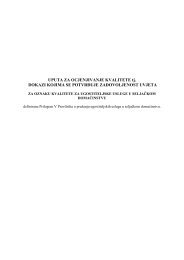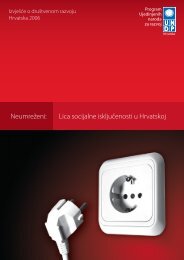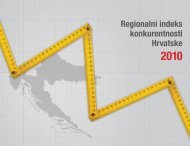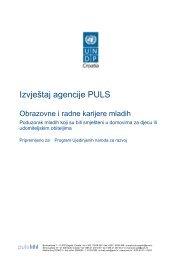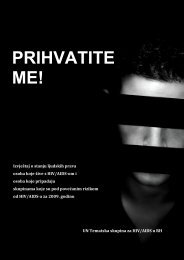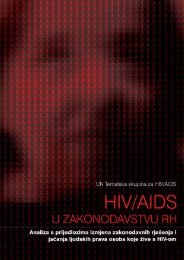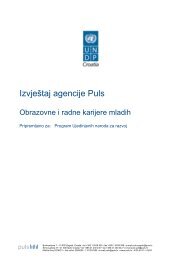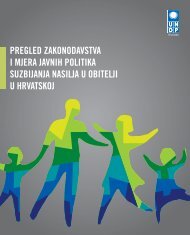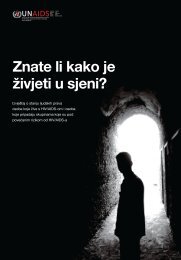WEB engleska verzija end.indd - UNDP Croatia
WEB engleska verzija end.indd - UNDP Croatia
WEB engleska verzija end.indd - UNDP Croatia
- No tags were found...
Create successful ePaper yourself
Turn your PDF publications into a flip-book with our unique Google optimized e-Paper software.
THE SOCIALLY EXCLUDEDCHAPTER 33.13.9 Media and HIVIn mid November 2004, a <strong>Croatia</strong>n journalist publishedan article about the supposed intentionalspread of HIV by a person in a larger <strong>Croatia</strong>n city,mentioning particular details and practically revealingthis person’s identity. The article, in addition todefaming the person in question, has most certainlycontributed to the tragedy of the person’s family.The greatest mistakes in media reporting on HIV arethe use of stigmatising language, a lack of source verificationand a sensationalist approach. It is paradoxicalthat the media reports always respect the anonymityof those who accuse others for the purposeful spreadof HIV, and that of public sources. The reaction of civilsociety to inappropriate behaviour by the media isinsufficient. While many NGOs express the readinessto establish public dialogue on the protection ofvulnerable social groups, there is a lack of any publicdialogue focused on the destigmatisation of peopleliving with HIV.3.13.10 Social Ties and Civil SocietyThe civil society is highly polarized when it comes toHIV. While the majority of institutions, media, and nongovernmentalorganizations have relatively liberalprinciples in relation to sexuality, religious institutionsand the Catholic Church advocate for HIV preventionprogrammes based on sexual abstinence, often s<strong>end</strong>ingmessages of condom inefficiency in the preventionof HIV spread. Dialogue and compromise between theconflicting parties are difficult to realise. As a result,there is no clear strategy for the prevention of HIV in<strong>Croatia</strong> among the young population, and all attemptsto develop school-based education programmes haveresulted in the postponement of their adoption, sinceneither the contents nor didactical aspects of theirimplementation have been agreed upon.According to the results of the <strong>UNDP</strong> Quality of Lifesurvey (2006a), 92.5% of participants have expressedtheir readiness to care for a family member infectedwith HIV, but 58% of them would prefer if a familymember’s condition remained a secret. Reponses toquestions such as would you buy fruit from a personliving with HIV, and should a teacher living with HIV beallowed to continue teaching, reveal some interestingpatterns. Almost one half of the participants (48.5%)would not buy fruit from a person living with HIV,with results varying in different counties and rangingfrom 35.5% (Zagreb County) to 66.6% (Šibenik-KninCounty). Up to 65% of participants agreed that anHIV positive teacher should be allowed to continueteaching, again showing large discrepancy amongthe counties that ranged from 80.8% (Town of Zagreb)to 44.3% (Šibenik-Knin County).Although it is difficult to deduce the complex socialorigins of stigmatisation and isolation for HIV patients,the data provided by the <strong>UNDP</strong> survey suggests somepossible explanations. The popular opinion thatpeople living with HIV should be avoided may be theresult of the fear of infection. However, this avoidancemay also be derived from stereotypical views thatthose who are infected take part in certain activitieswhich are viewed negatively by the community. Ifthe primary reason was fear of infection, it wouldbe expected that the largest number of participantswould answer negatively to questions regardingclose daily contact with patients living with HIV, suchas taking care of an infected family member. However,the results of the survey run contrary to this assumption,which would lead one to conclude that fear ofinfection is not the primary motivator behind thestigmatisation of patients living with HIV. Therefore itis more probable that the stigmatisation stems fromthe stereotypical negative views of the risk behaviourassociated with infection, and not only from the fearof becoming infected. The fact that the majority ofparticipants would want a family member’s conditionto be kept secret supports this hypothesis.3.13.11 Key ChallengesThe key challenge is the acceptance of people livingwith HIV and a wide range of life situations affectedby HIV, such as the prevention of HIV transfer duringpregnancy and child birth, kindergarten enrolment,realisation of a teenager that he/she is living with HIV,schooling, employment, long-term care in the family,serious drug side-effects and accepting the illness assuch. Intravenous drug users should be provided withgreater access to clean needles, while sexual healthprogrammes targeting men having sex with menshould differ from programmes targeting secondaryschoolpopulation. The vulnerability of women withregards to HIV should be emphasized and negativeexamples of the discrimination pointed out.115



